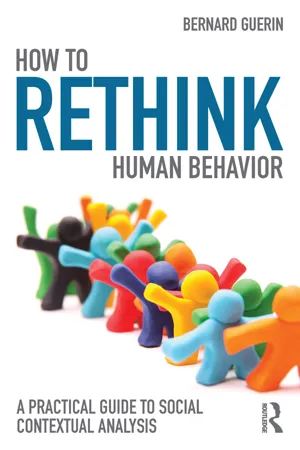
How to Rethink Human Behavior
A Practical Guide to Social Contextual Analysis
- 262 pages
- English
- ePUB (mobile friendly)
- Available on iOS & Android
About this book
Developed from the author's long teaching career, How to Rethink Human Behavior aims to cultivate practical skills in human observation and analysis, rather than offer a catalogue of immutable 'facts'. It synthesizes key psychological concepts with insights from other disciplines, including sociology, social anthropology, economics, and history.
The skills detailed in the book will help readers to observe people in their contexts and to analyze what they observe, in order to make better sense of why people do what they do, say what they say, and think what they think. These methods can also be applied to our own thoughts, talk and actions - not as something we control from 'within' but as events constantly being shaped by the idiosyncratic social, cultural, economic and other contexts in which our lives are immersed.
Whether teaching, studying, or reading for pleasure, this book will help readers learn:
- How to think about people with ecological or contextual thinking
- How your thinking is a conversation with other people
- How to analyze talk and conversations as social strategies
- How capitalist economies change how you act, talk and think in 25 ways
- How living in modern society can be linked to generalized anxiety and depression
How to Rethink Human Behavior is important interdisciplinary reading for students and researchers in all fields of social science, and will especially appeal to those interested in mental health. It has also been written for the general reading public who enjoy exploring new ideas and skills in understanding themselves and other people.
Frequently asked questions
- Essential is ideal for learners and professionals who enjoy exploring a wide range of subjects. Access the Essential Library with 800,000+ trusted titles and best-sellers across business, personal growth, and the humanities. Includes unlimited reading time and Standard Read Aloud voice.
- Complete: Perfect for advanced learners and researchers needing full, unrestricted access. Unlock 1.4M+ books across hundreds of subjects, including academic and specialized titles. The Complete Plan also includes advanced features like Premium Read Aloud and Research Assistant.
Please note we cannot support devices running on iOS 13 and Android 7 or earlier. Learn more about using the app.
Information
1
RATIONALE AND BASIC SOCIAL ANALYTIC SKILLS
The plan for you to learn the skills: an overview
| Skills to be learned | Chapter | |
| 1 | Making contextual observations | 1 |
| 2 | Contextual analysis with possibility training | 1 |
| 3 | Avoiding stereotypes in your analyses | 1 |
| 4 | Learning from similar analyses and experts | 1 |
| 5 | Analysing and observing resources | 2 |
| 6 | Analysing and observing populations and audiences | 2 |
| 7 | Analysing and observing exchange and generalized exchange | 2 |
| 8 | Analysing and observing secrecy | 2 |
| 9 | Analysing and observing monitoring | 2 |
| 10 | Trust as the interplay of secrecy and monitoring | 2 |
| 11 | Strategic usurpation as a common but overlooked analysis | 2 |
| 12 | Analysing and observing social context | 3 |
| 13 | Analysing the social properties of economic systems | 4 |
| 14 | Analysing the social properties of a capitalist economy (twenty-five tricks) | 4 |
| 15 | Analysing the social inequalities and stratifications of life opportunities | 5 |
| 16 | Analysing the social and behavioural outcomes of gender inequalities | 5 |
| 17 | Analysing other lack of opportunities | 5 |
| 18 | Tricks for observing the contexts of opportunity (six tricks) | 5 |
| 19 | Tricks for analysing and observing historical contexts (three tricks) | 6 |
| 20 | Tricks for analysing and observing the cultural contexts (four tricks) | 7 |
| 21 | Tricks for analysing and observing all five contexts | 7 |
| 22 | Analysing language use is analysing social contexts and strategies | 8 |
| 23 | Observing language use in everyday life | 8 |
| 24 | The many verbal micro-strategies to represent or portray the world | 8 |
| 25 | Strategies to keep and entertain your audience | 8 |
| 26 | The many verbal micro-strategies to massage your social relationships | 8 |
| 27 | Analytic questions to explore the contexts of thinking | 9 |
| 28 | Contextual observations and thoughts: ‘reading people’s minds’ | 9 |
| 29 | Methods for analysing thoughts-in-their-contexts | 9 |
| 30 | Methods for analysing bluff games and their challenges | 10 |
| 31 | Methods for analysing social dilemma games | 10 |
ANALYSIS BOX 1

ANALYSIS BOX 2
Table of contents
- Cover
- Half Title
- Title Page
- Copyright Page
- Table of Contents
- List of Tables
- List of Figures
- Preface
- Acknowledgements
- 1 Rationale and basic social analytic skills
- 2 The basics of practical social analysis
- 3 Analysing and observing social relationship contexts
- 4 Analysing and observing economic contexts
- 5 Analysing and observing the contexts for environmental opportunities
- 6 Analysing and observing historical contexts
- 7 Analysing and observing cultural contexts
- 8 The contexts for language use: conversation and other discourses
- 9 Analysing the contexts for thinking
- 10 Analysing social strategy
- Index